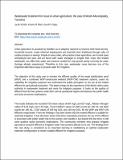| dc.description.abstract | Urban agriculture is practiced by dwellers as an adaptive response to improve their food security, household income, create informal employment and diversify their livelihood through sales of surplus produce or savings. People in many cities, who practice urban agriculture, are in most cases unemployed and poor and are faced with water shortages to irrigate their crops. But treated wastewater can offer both water and nutrients needed for crop growth partly covering the water shortage already experienced. Therefore in this case, wastewater reuse becomes one of the important alternative ways to provide water for irrigation.
The objective of this study was to monitor the effluent quality of the waste stabilization pond (WSP) and a combined WSP-constructed wetland (WSP-CW) treatment systems, assess its suitability for irrigation purposes and understand the public perception on the use of the treated effluent for agricultural production. This paper brings out the experience of the Moshi urban water authority in wastewater treatment and reuse for irrigation purposes. It looks on the quality of effluent from the two systems under their current operational regime and deduces the public health and socio economic implications.
The results indicates the recorded TDS mean values of 587 mg/L and 627 mg/L, Nitrate–Nitrogen values of 9.19 mg/L and 2.35 mg/L, Fecal Coliform values of 1000 counts per 100 mL and 4626 counts per 100 mL, COD values of 159 mg O2/L and 149 mg O2/L for the WSP and WSP-CW effluents respectively. From the findings it has been shown that the treated effluent is suitable for restricted irrigation. It has also been shown that when improperly practiced, the use of the effluent is associated with public health risk to the workers who handle it, but despite this fact there is still some positive social economic implications. The community members who practice irrigated agriculture using the effluent as irrigation water have positive attitude on its use. The findings from this case study, is considered as an important learning in establishing an optimal wastewater treatment configuration to render suitable effluent for irrigation purposes. | en_US |

